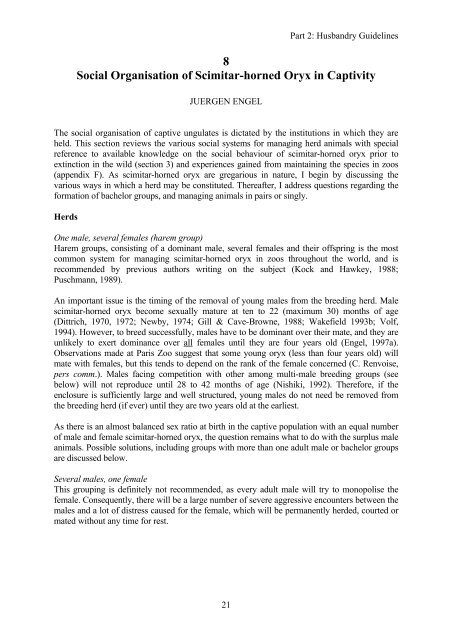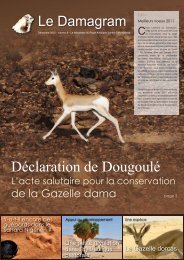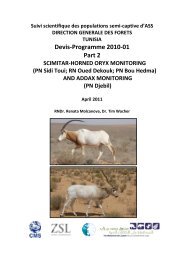The Biology, Husbandry and Conservation Scimitar-horned Oryx ...
The Biology, Husbandry and Conservation Scimitar-horned Oryx ...
The Biology, Husbandry and Conservation Scimitar-horned Oryx ...
Create successful ePaper yourself
Turn your PDF publications into a flip-book with our unique Google optimized e-Paper software.
21<br />
Part 2: <strong>Husb<strong>and</strong>ry</strong> Guidelines<br />
8<br />
Social Organisation of <strong>Scimitar</strong>-<strong>horned</strong> <strong>Oryx</strong> in Captivity<br />
JUERGEN ENGEL<br />
<strong>The</strong> social organisation of captive ungulates is dictated by the institutions in which they are<br />
held. This section reviews the various social systems for managing herd animals with special<br />
reference to available knowledge on the social behaviour of scimitar-<strong>horned</strong> oryx prior to<br />
extinction in the wild (section 3) <strong>and</strong> experiences gained from maintaining the species in zoos<br />
(appendix F). As scimitar-<strong>horned</strong> oryx are gregarious in nature, I begin by discussing the<br />
various ways in which a herd may be constituted. <strong>The</strong>reafter, I address questions regarding the<br />
formation of bachelor groups, <strong>and</strong> managing animals in pairs or singly.<br />
Herds<br />
One male, several females (harem group)<br />
Harem groups, consisting of a dominant male, several females <strong>and</strong> their offspring is the most<br />
common system for managing scimitar-<strong>horned</strong> oryx in zoos throughout the world, <strong>and</strong> is<br />
recommended by previous authors writing on the subject (Kock <strong>and</strong> Hawkey, 1988;<br />
Puschmann, 1989).<br />
An important issue is the timing of the removal of young males from the breeding herd. Male<br />
scimitar-<strong>horned</strong> oryx become sexually mature at ten to 22 (maximum 30) months of age<br />
(Dittrich, 1970, 1972; Newby, 1974; Gill & Cave-Browne, 1988; Wakefield 1993b; Volf,<br />
1994). However, to breed successfully, males have to be dominant over their mate, <strong>and</strong> they are<br />
unlikely to exert dominance over all females until they are four years old (Engel, 1997a).<br />
Observations made at Paris Zoo suggest that some young oryx (less than four years old) will<br />
mate with females, but this tends to depend on the rank of the female concerned (C. Renvoise,<br />
pers comm.). Males facing competition with other among multi-male breeding groups (see<br />
below) will not reproduce until 28 to 42 months of age (Nishiki, 1992). <strong>The</strong>refore, if the<br />
enclosure is sufficiently large <strong>and</strong> well structured, young males do not need be removed from<br />
the breeding herd (if ever) until they are two years old at the earliest.<br />
As there is an almost balanced sex ratio at birth in the captive population with an equal number<br />
of male <strong>and</strong> female scimitar-<strong>horned</strong> oryx, the question remains what to do with the surplus male<br />
animals. Possible solutions, including groups with more than one adult male or bachelor groups<br />
are discussed below.<br />
Several males, one female<br />
This grouping is definitely not recommended, as every adult male will try to monopolise the<br />
female. Consequently, there will be a large number of severe aggressive encounters between the<br />
males <strong>and</strong> a lot of distress caused for the female, which will be permanently herded, courted or<br />
mated without any time for rest.





